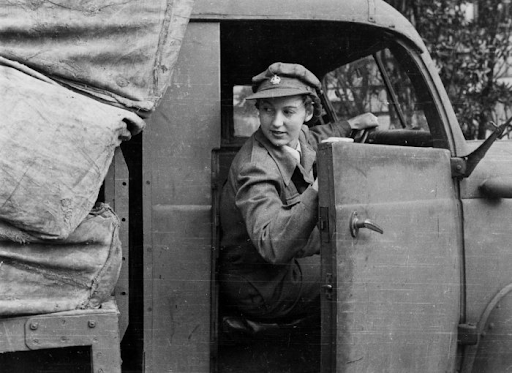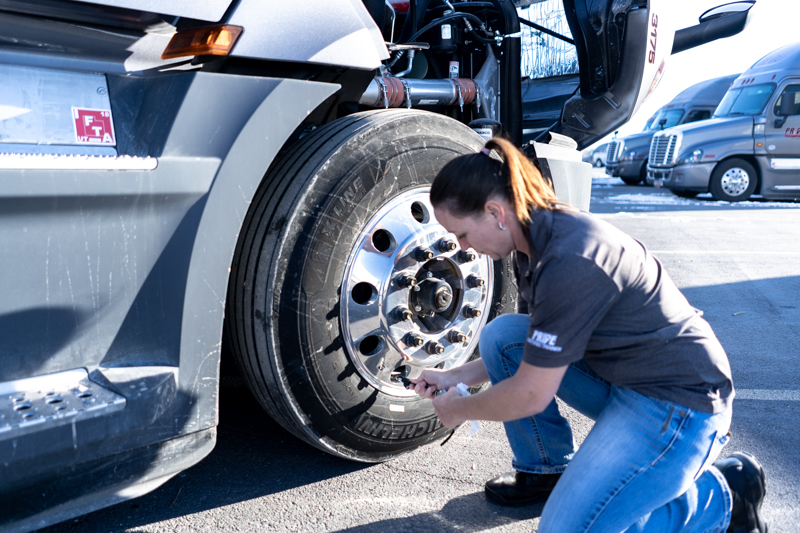by Pride Transport | Sep 30, 2019
On Thursday, August 18, in the year 1920, the 19th amendment was ratified into law in these United States, giving women the right to vote. And, that was it, the rest of history shows that women have had it easy. They don’t have to struggle with reproductive rights or equal pay or being taken seriously in a male-dominated business, Nope, they got the 19th amendment passed and since then it’s been all roses in Picardy and smooth sailing.
Now for those who dwell deeply in reality.
One of the most male-dominated business going is the truck driving industry. People assume that these large rigs are too much for a little lady to handle and best left to the menfolk. You ladies git your sweet little tails back into the kitchen, we men will take it from here.
If that sounds ridiculous and like a load of horse pucky to you, good, you’re seeing the world clearly. If you think that kind of view of women in the trucking industry is correct then, you have another think coming.
The truth is women have been a major part of the freight transportation industry for over a century. But to say it has been easy for them is to ignore the realities of the struggles women go through, have gone through and will continue to go through all of their lives. Easy is not how one would describe women finding their place in trucking and keeping that place as well as paving the way for more women to have careers in truck driving.
Some History
Women have been there, in the cab, driving the trucks since the beginning. Luella Bates is one of the earliest truck drivers on record. She drove a class B truck for the Four Wheel Drive Auto Company in Clinton, Wisconsin between 1918 and 1922. She was one of the very first women to be licensed as a truck driver. However, Lillie Elizabeth McGee Drennan is often credited with being the first licensed female truck driver in our great nation's history.
Lillie had a rather unhappy life. She only achieved a fifth-grade education before she was married at age 15 and became a mom. Two years later she was divorced. She was married and divorced three times in her life. During the second marriage, she was introduced to the trucking business and she knew it was her calling. She soon became a truck driver herself and eventually, she became the sole owner of the Drennan Truck Line.

During WWII female truck drivers were more common. In fact, most jobs in male-dominated fields became open and occupied by women as all the men were off fighting the war. Women were often encouraged to take jobs in the male-dominated industries to help the country, make some serious money and keep the economy going. The funny thing is when women took over the jobs that were usually done by men, they thrived. This country could not have survived without the industrious drive of the women who stayed behind and held down the jobs while their men were away. The image of Rosie the Riveter could easily have Tammy the Truck Driver. Women were an important and integral part of this nation's economy while the men were away. Without women stepping into the workforce, to rivet, and drive, build and weld, the country may have won WWII, but the devastation on the economy at home would have been drastic. Women kept this country alive during the war.
Cut to the end of the war, glorious victory, the boys come back home and what happens to women? Well, thanks for filling in but now, you need to go back to your kitchens and your Jello-molds and let the menfolk take it from here. Women were pushed back into their prewar lives and men picked up like nothing ever happened.
Life would have gone along that way except that the sexual revolution happened and women started making their voices heard and their strengths known. During the ‘60s the sexual revolution was really starting to heat up and with all that heat, equality issues bubbled up to the surface. In this bubbling, the workplace was given a long, hard look as equal opportunity was becoming a major issue of the day.
In the 1970s, the bubbling had become a boil and the Coalition of Women Truck Drivers was just one of the many women-centric organizations that were formed.
In the early days, there were 150 members and their task was to fight the sexual misconduct that was taking place in trucking companies.
The Coalition paved the way for modern recruiting campaigns that help to encourage more women to seek employment in the trucking industry.
Rusty Dow, was the first woman to drive with a full load on the Alaska Highway. She did this incredible feat in 1944 when she was a truck driver for the U.S. Army Engineers/Alaska Defense Command during WWII.
Today it is widely recognized that women make excellent professional truck drivers, many companies employ females and count them among their very best drivers. Despite their skill, their abilities equal to those of their male counterparts, there is only 6.2% of the truck driving workforce that is female. History makes it plain, women are great truck drivers but, not many people seem to be fans of history.
Still Not Easy
Despite the fact that women have proven themselves to be important and vital to the trucking industry, the ones who are trying to get into truck driving today still face issues. Thankfully there are organizations such as realwomenintrucking.com to aid women as they move into the truck driving industry. Real women is a non -profit organization that was founded to help encourage gender equality in the truck driving industry. This organization also serves to inform people about the hard-working women, past and present, who have helped shape the trucking industry for the better.
Education
Ellen Voie, founder of the non-profit Women in Trucking Association, is a strong advocate of women being educated before they go into the trucking business. Like many others in the business, she sees education as being imperative for women seeking a smoother entry into this traditionally male-dominated industry.
Education is important to the new as well as veteran female drivers. Education helps women realize their rights as an equal opportunity employee. Education can also help women in the workforce if they do encounter a rare case of sexual misconduct. Women often help male drivers learn and understand how together they can help the industry to face and overcome issues of sexual misconduct that sometimes persist even today in some parts of the trucking industry.
But Seriously, Men
 Men need to take it upon themselves to work with their female counterparts and get educated themselves. Men should understand the right way and the wrong ways to address and work with female drivers. This education can help male drivers talk to each other and set new drivers on the right track to working in harmony, creating healthy, safe environments and recognizing the important role women play as truck drivers. Most men are very aware of what behavior makes women feel welcome and as an important part of the industry. They’re doing more and more to make that positive behavior the norm and most male drivers will tell you It’s not that difficult.
Men need to take it upon themselves to work with their female counterparts and get educated themselves. Men should understand the right way and the wrong ways to address and work with female drivers. This education can help male drivers talk to each other and set new drivers on the right track to working in harmony, creating healthy, safe environments and recognizing the important role women play as truck drivers. Most men are very aware of what behavior makes women feel welcome and as an important part of the industry. They’re doing more and more to make that positive behavior the norm and most male drivers will tell you It’s not that difficult.
Ellen Voie, through her organization, says that women working in a male-dominated industry, like truck driving, are constantly being forced to prove their worth and that they belong in the industry. When a female driver pulls into a loading dock, she is often met with skepticism and the men stand around watching, judging and commenting as she backs up the rig. This kind of behavior happens to new male drivers as well but the difference is, when the new driver has put some miles behind him and has gained experience, the judgment stops.
Thankfully this sort of thing is becoming rarer in the truck driving industry. The notion that truck driving is “man’s work” has begun to fade deeper into the background. Male drivers know the value of their female counterparts. They have respect for female drivers and are thankful for their efforts and the changes they have brought about in the industry
However, this is a situation where it’s up to men to give women drivers credit and recognize their time and experience in the business. Voie understands the casual ribbing and the playful insults that are exchanged in the workplace and she doesn’t feel women should be immune to that. There is an adjustment needed on both sides but, the bulk of the burden will rest on men because they have been at the controls of the industry for so long.
Employers are also making strides to improve conditions for women in trucking, by offering education and awareness programs to combat harassment in the workplace. These programs can also work to raise the retention rates of drivers and create a more supportive environment for current and future female drivers.
Education also helps women overcome the mentality that they have to pit themselves against one another. Many women in the industry feel they have no one to thank, no one who has been on their side and so they don’t feel the need to help any other women, the atmosphere becomes very dog eat dog. But, being educated to the history of trucking and the many ways women have improved and furthered it, as they did during war times, opens their eyes to the great lengths women have gone to in order to secure women a place in the industry.
The Present
Many men and women agree that the industry has come a long way in being more welcoming to women. For most female drivers there are positives that make the job worthwhile. These drivers say the pay, benefits and the flexibility certainly outweigh the few negatives that may have plagued the industry in the past.
In 2014, the women in trucking Association partnered with the Girl Scouts of America to create the Girl Scout Transportation Patch. Voie and her team travel throughout the U.S. and Canada to tell young women about the many benefits in trucking. They have also released a doll named Clare, a truck driver, to help introduce little girls to the idea of trucking.
Challenges
Despite changes and improvements for women, they can still face challenges when they enter the trucking industry. Organizations like Voie’s are working hard to face and ease those challenges. Working with male drivers, educating them and opening their eyes to situations that may feel negative, Voie’s organization has taken the industry leaps and bounds forward in dealing with misconduct and fostering acceptance.
The issue of harassment will always need to be dealt with. Many believe that what’s perceived as verbal harassment is simply guys giving each other a hard time, it’s just the way it is. But, there can be a difference between the way a man jokes with another man about their work and their skill and the way men deal with, or “joke with” women drivers. Many believe that it’s up to both men and women to step up, speak up and call attention to this difference and have rational discussions about it. Most men don’t mean any harm or have any problem with their female driver co-workers, they simply need a little push toward understanding and education to make the workplace feel safer for women.
What Is Said
Women deal with the jokes and comments announced by hecklers on the CB radio and there is really nothing they can do about it. If a woman driver points out the harassment, it only increases.
Some male drivers, those who seem to be perpetually stuck in the 1950s, say women need to “lighten up ” learn how to “take a joke” and “get a sense of humor”. But, frankly, that’s bullcrap and most male drivers realize that. Men are stepping up and coming to understand that women are a vital part of this industry and understand making them feel safe and accepted is important. No one is forcing the few men who don’t get it to say negative things and act in negative ways, they’re making the choice to behave that way and with education and understanding, they can make the choice to stop.
There is no getting around the fact that the women who are strong and tough, the ones who have learned to play the game and take a little criticism in this male-dominated industry, are able to break through, persevere and make the industry work for them in many positive ways.
Today
 Mostly it’s pure ignorance and it is really a very small portion of men who have a problem with women driving trucks. In time, the majority of men who welcome women into their ranks will put an end to the lingering pockets of harassment and take a stand beside their colleagues, male and female.
Mostly it’s pure ignorance and it is really a very small portion of men who have a problem with women driving trucks. In time, the majority of men who welcome women into their ranks will put an end to the lingering pockets of harassment and take a stand beside their colleagues, male and female.
Despite the low numbers, women still make up only 6% of the industry, women have a place and a history in the trucking industry that cannot be denied or ignored. The history of the industry shows women stepping up and excelling when the country needed them most and then, gracefully, stepping back so men could have their jobs when they returned from war.
In this sense, men and women have been working together in the trucking industry for a century. In the future, more women will understand the great benefits and the service to the country that truck drivers provide and they will join the ranks of professional drivers keeping the nation supplied and always moving forward.
Women have a place in the industry. They have earned it in the past and continue to do so event today. Driving a truck is a great job for women and those who do it say it’s the best job they have ever had. Despite the challenges, women have always stepped up, faced the challenges in front of them and succeeded. Trucking companies are beginning to recognize that kind of drive and grit and they are doing more and more to make women feel safe, welcome and needed. There is still a ways to go but, if you ask a women driver, she’ll tell you, we’ve come a long way, baby.